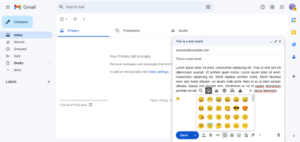
Back جي ميل Arabic چى ميل ARZ জিমেইল Assamese Gmail Azerbaijani Gmail Byelorussian Gmail BE-X-OLD Gmail Bulgarian জিমেইল Bengali/Bangla Gmail BS Gmail Catalan
 A screenshot of a Gmail inbox and compose box on Gmail's own webmail interface | |
Type of site | Webmail |
|---|---|
| Available in | 133 languages |
| Owner | |
| Created by | Paul Buchheit |
| URL | mail |
| Commercial | Yes |
| Registration | Required |
| Users | 1.5 billion (October 2019)[1] |
| Launched | April 1, 2004 |
| Current status | Active |
Content license | Proprietary |
| Written in | Java, C++ (back-end), JavaScript (UI)[2] |
Gmail is the email service provided by Google. As of 2019,[update] it had 1.5 billion active users worldwide, making it the largest email service in the world.[1] It also provides a webmail interface, accessible through a web browser, and is also accessible through the official mobile application. Google also supports the use of third-party email clients via the POP and IMAP protocols.
At its launch in 2004, Gmail (or Google Mail at the time) provided a storage capacity of one gigabyte per user, which was significantly higher than its competitors offered at the time. Today, the service comes with 15 gigabytes of storage for free for individual users, which is divided among other Google services, such as Google Drive, and Google Photos.[3] Users in need of more storage can purchase Google One to increase this 15 GB limit across most Google services.[4] Users can receive emails up to 50 megabytes in size, including attachments, and can send emails up to 25 megabytes. Gmail supports integration with Google Drive, allowing for larger attachments. Gmail has a search-oriented interface and supports a "conversation view" similar to an Internet forum.[5] The service is notable among website developers for its early adoption of Ajax.
Google's mail servers automatically scan emails for multiple purposes, including to filter spam and malware and, prior to June 2017, to add context-sensitive advertisements next to emails. This advertising practice has been significantly criticized by privacy advocates with concerns over unlimited data retention, ease of monitoring by third parties, users of other email providers not having agreed to the policy upon sending emails to Gmail addresses, and the potential for Google to change its policies to further decrease privacy by combining information with other Google data usage. The company has been the subject of lawsuits concerning the issues. Google has stated that email users must "necessarily expect" their emails to be subject to automated processing and claims that the service refrains from displaying ads next to potentially sensitive messages, such as those mentioning race, religion, sexual orientation, health, or financial statements. In June 2017, Google announced the end of the use of contextual Gmail content for advertising purposes, relying instead on data gathered from the use of its other services.[6]
- ^ a b Petrova (October 26, 2019). "Gmail dominates consumer email with 1.5 billion users". CNBC.com. Archived from the original on November 17, 2019. Retrieved November 19, 2019.
- ^ Siegler, MG (March 14, 2010). "The Key To Gmail: Sh*t Umbrellas". TechCrunch. AOL. Archived from the original on October 22, 2016. Retrieved October 27, 2018.
- ^ "Manage files in your Google Drive storage - Gmail Help". support.google.com. Retrieved February 11, 2023.
- ^ "Buy more Google storage - Computer - Google Drive Help". support.google.com. Retrieved April 4, 2023.
- ^ "Group emails into conversations - Computer - Gmail Help". support.google.com. Retrieved December 8, 2023.
- ^ Cite error: The named reference
No contextual adswas invoked but never defined (see the help page).